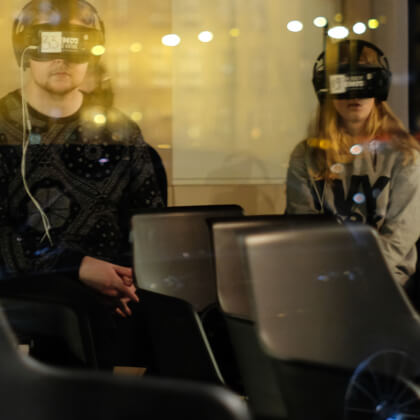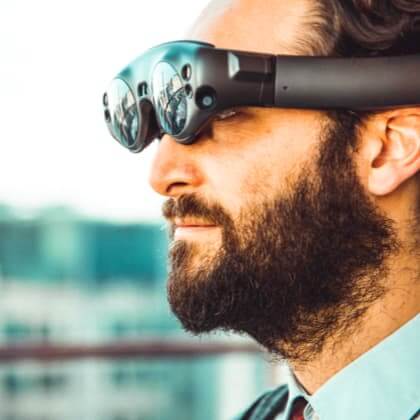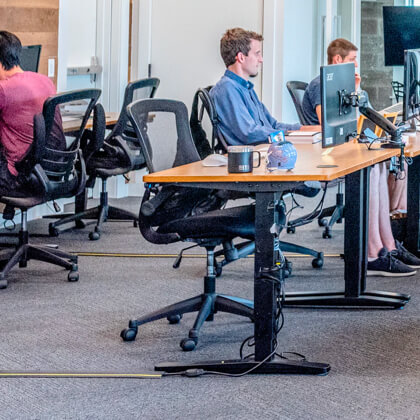Gaming and entertainment industries are now trying to get as much as possible out of AR and VR technologies. The number of AR-powered apps’ users multiplies each day; the respective revenues also increase. At the same time, entrepreneurs worldwide just watch cautiously after what these technologies can bring. Only a small percentage of companies have employed AR and VR in a truly appropriate, highly-profitable way. The reason is simple: people are still unfamiliar with the cutting-edge technologies that actually have the potential to change numerous industries.
We have been often asked why and how companies use augmented reality. Forecasts say that the AR & VR market will have grown up to nearly $52 billion in total revenue by 2027. So, it is fair enough to employ these technologies in business. We prepared this article to diminish your doubts and hesitations concerning augmented reality campaigns and inspire you to make a great step towards an ultimate enhancement of your business.
3 key reasons customers like AR apps
First of all, let’s define 3 main reasons why customers prefer to use AR technologies.
Drop of entertainment
Customers like experiencing AR technologies, because they provide fun ‘gaming’ elements. A great opportunity to ‘play’ a few seconds when choosing a laptop for work or a coffee machine in an online store increases customer engagement and motivates them to click a Checkout button.
Sort of a free trial
AR brings customer experience to a new level. The technology helps to conveniently try on apparel or jewelry, make sure that the desired furniture fits the room or move to a place one is planning to travel to in a virtual manner for a couple of seconds. And all of that can be done remotely. AR provides the opportunities no other tech is capable to yet. And keep in mind that 40% of customers are even ready to pay more for a product if they experience it using AR.
A new level of interaction
Consumers are more open to augmented reality brands. Using a brand’s AR app, they interact with brand founders in a new better way. Which, in turn, makes them more loyal to a certain brand.
AR can improve a variety of businesses and their corresponding aspects, from real estate agencies or media channels to gyms or government institutions. However, it has the greatest impact on retail. Both traditional and online stores can benefit from a dedicated AR application.
How brands use augmented reality? First of all, successful brands use them for advertising and marketing purposes. Augmented reality marketing campaigns are powerful enough to attract thousands of potential customers in a matter of days! And numerous businesses have already implemented AR technologies. Let’s find out more about some real success stories.
How brands use augmented reality: 7 best examples
These days, both world-famous brands and small startups make financial gain from the AR usage. There is no better way to make the right decision than to discover some inspiring examples of how brands use augmented reality. So, here they are:
L’Oreal
L’Oreal has demonstrated the beauty industry front-runners how to improve the business properly. This company is one of the early AR adopters that actually succeed with cutting edge technologies.
As you know, customers often hesitate about shopping online. It still seems risky to buy a product without trying it on. But L’Oreal and several other brands change the online shopping experience.
The company’s software development team has built 2 great apps:
- Makeup Genius,
- and Style My Hair.
The tools allow trying on makeup and hairstyles virtually. Customers worldwide loved the opportunities and experience provided with these brand-new apps.
In 2017, L’Oreal added its products to the YouCam Makeup app. The app was downloaded over 100 million times in 2017 and won the App Store Award.
In 2018, L’Oreal started augmented reality collaboration with the biggest social network, Facebook.
Sephora
Sephora, another beauty industry representative, has implemented a slightly different approach. Unlike Makeup Genius, where you can try on makeup in a real-time mode, Virtual Artist augments your selfie with the type of cosmetics you choose. Its unique feature is that the app demonstrates how your skin will change after using a certain product.
The application helps customers with decision-making, improves the process of purchase, and speeds up the checkout process.
Lacoste
Lacoste has launched a complex AR solution that deals with several tasks:
- It allows trying on shoes virtually;
- It powers window displays and signages;
- It is an essential part of promotional postcards.
The key aim of this AR campaign was the engagement of a younger audience. The company’s specialists believed this method to attract youth, provide a new level of entertainment elements and increase sales. And their forecasts came true: more than 30,000 customers enjoyed the Lacoste 3D experience.
Coca-Cola
Do you remember good old Coca-Cola Christmas ads? Launched 8 years ago, it has won our hearts for a lifetime! And in 2014, Coca-Cola made another significant step towards the advertising improvement. The company’s developers employed AR & VR technologies to deliver the high-quality Magic app. By simply scanning posters from the defined locations, users could see Santa right by their side.
IKEA
Industry leaders opting for AR technologies are the best proofs AR is worth it. In 2013, IKEA launched their AR Catalog app and provided their potential customers with great visualization opportunities.
How does it all happen? A customer downloads the app on a smart device, captures an image of a whole room or its certain part with a camera, and sees how a certain IKEA product will look like there. There is no need for interested customers to buy products can hurry home worrying whether a piece of furniture will fit their house.
“A better reality”. You can find these words on a web page describing this augmented reality example. An IKEA AR app demonstrates customers improved, better versions of their homes.
Do you think the use of AR in marketing is only beneficial for retail companies? Here are some notable examples that may change your opinion.
Read more about the value of customer reviews for the best software development company.
The New York Times
Implementing augmented and virtual reality technologies in media channels, we get one step closer to the clear and precise understanding of any situation. AR helps to increase compassion, empathy, and awareness in global mankind problems.
The New York Times started using VR and AR in their work in 2015 with an app describing a touching story about the victims of the war. After that, the company launched 20 films covering different vital topics like global warming and space exploration.
With no exaggeration, one of the most successful products was the AR article about the Winter Olympics. Readers (and viewers at the same time) got access to a preview of the event. They could walk around, view the scene from the different sides. The article made them feel like they actually visited the Olympic games.
American Express
American Express, one of the most expensive brands in the world, started to incorporate AR and VR technologies in 2015. The company launched the “You vs Sharapova” onsite VR game. It was a great source of entertainment for Amex events attendees. In 2017, one more interesting VR campaign called “Air Tennis” was launched. And a year later, in 2018, the company released a powerful AR app.
It was the official mobile app for Coachella annual music festival. With its help, American Express cardholders got an opportunity to buy products anywhere on the territory of the festival.
Innovative solutions and revolutionizing ideas help leading companies keep their positions. These memorable examples attracted even more attention to American Express and provided their former and potential customers with a unique experience.
The number of AR/VR users is expected to reach 2,593.1 million by 2027, and the number of companies using AR keeps raising. Though this number is impressive, it is not as huge as all the number of opportunities these technologies provide. Proper implementation of AR into advertising and marketing campaigns leads to the sky-high sales increase. And if you are not using this method yet, you simply refuse to obtain a leading position in your niche. The modern market has strict rules. Years of experience helped us to identify these rules, and one of them is the following: you either use innovative tools and methods or lose your customers. Do you agree with that statement? What do you think about AR and its potential for your business? If some questions remain, just drop us a line so we can make everything clearer fo you.
Need a certain developer?
Use our top talent pool to get your business to the next level.











